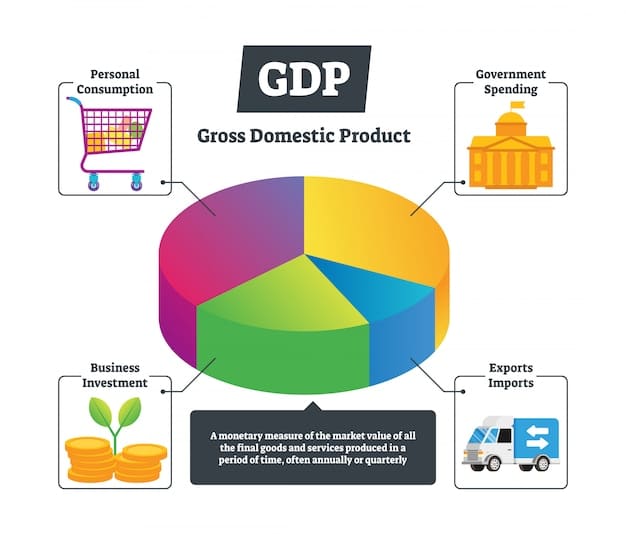US Social Security Policy: Changes & Retirement Impact

Understanding evolving US Social Security policies is crucial for current and future retirees, as projected changes could significantly alter benefit structures and determine the financial landscape of retirement planning.
For millions across the United States, Social Security represents a cornerstone of retirement security, yet the program faces intricate challenges stemming from demographic shifts and evolving economic realities. Delving into US Social Security Policy: What Changes Are Coming and How Will They Affect Your Retirement? offers a vital perspective, allowing individuals to proactively navigate potential shifts and safeguard their financial future.
Understanding the Social Security Program’s Foundations
Social Security remains a bedrock of the American welfare system, providing financial benefits to retirees, the disabled, and survivors of deceased workers. Established in 1935 as a response to the Great Depression, its initial goals were to provide a safety net for vulnerable populations. Over the decades, it has expanded to encompass a broader range of beneficiaries, becoming an indispensable part of the retirement planning landscape for most Americans.
The program operates on a pay-as-you-go system, meaning current workers’ contributions largely fund the benefits of current retirees and other beneficiaries. This intergenerational contract ensures a continuous flow of funds, maintaining the program’s solvency. However, this structure also makes it susceptible to demographic shifts, economic fluctuations, and legislative changes, all of which can impact its long-term viability.
Historical Context and Evolution
From its inception, Social Security has adapted to societal needs, expanding coverage and benefit types. Early amendments broadened covered occupations, and later reforms, such as the indexing of benefits to inflation (Cost-of-Living Adjustments, or COLAs), aimed to preserve purchasing power. These historical changes underscore the program’s dynamic nature and its continuous effort to meet the evolving demands of the populace.
- 1935: Initial Social Security Act signed into law, providing for old-age benefits.
- 1956: Disability benefits added, expanding the program’s scope beyond retirement.
- 1972: Cost-of-Living Adjustments (COLAs) made automatic, linking benefits to inflation.
- 1983: Major reforms enacted, including taxation of benefits and raising the full retirement age, to address solvency concerns.
The system’s reliance on contributions from current workers means that changes in birth rates, life expectancy, and economic productivity significantly influence its financial health. As the population demographics shift, the ratio of workers to retirees becomes a critical factor in the program’s sustainability, prompting ongoing discussions about necessary adjustments.
Understanding these foundational elements is crucial as we examine the challenges and potential policy changes ahead. The program’s design, while robust, requires careful stewardship to ensure it continues to meet its commitments to future generations of beneficiaries.
Demographic Pressures and Solvency Concerns
The financial health of Social Security is intrinsically linked to demographic trends, primarily the shifting ratio of workers to beneficiaries. The “baby boomer” generation, a large cohort born post-World War II, is now largely retired or nearing retirement. This demographic bulge, combined with lower birth rates in subsequent generations and increased life expectancy, is putting unprecedented strain on the program’s pay-as-you-go funding model.
The Social Security Administration’s annual Trustees’ Reports consistently highlight these challenges, projecting that the trust funds are on track to become depleted within the next decade. While depletion doesn’t mean the program collapses entirely—it would still be able to pay a significant portion of scheduled benefits from ongoing tax revenues—it does signal an inability to meet 100% of its obligations without intervention. This looming shortfall necessitates a critical examination of potential policy adjustments.
Factors Contributing to the Solvency Gap
Several interconnected factors contribute to the projected funding shortfall. Each plays a role in widening the gap between the program’s income and its outgo, making comprehensive reform a complex but necessary endeavor.
- Declining Birth Rates: Fewer new workers are entering the workforce to replace those retiring, reducing the overall contribution base.
- Increased Life Expectancy: People are living longer, meaning they collect benefits for more years than originally projected, increasing the total payout.
- Slower Wage Growth: If wages do not grow as quickly as projected, the amount of FICA taxes collected will be less than anticipated.
- Inequality in Life Expectancy: While average life expectancy has increased, gains have not been uniform across all socio-economic groups, complicating discussions around uniform policy changes.
These demographic and economic realities mean that the current system, without modifications, cannot sustain its promised benefit levels indefinitely. The urgency of addressing these issues grows with each passing year, as delaying reforms tends to necessitate more drastic measures down the line. Policymakers face the delicate balance of preserving the program’s integrity while minimizing adverse impacts on current and future retirees.
Therefore, understanding these underlying pressures is essential for anyone interested in the future of Social Security and its implications for retirement planning. The solutions will likely involve a combination of approaches, each with its own set of trade-offs.

Proposed Policy Changes and Their Implications
Addressing Social Security’s long-term financial challenges requires considered policy adjustments. Various proposals have been put forth, each with differing impacts on various segments of the population. These changes broadly fall into two categories: increasing revenue or decreasing outlays.
One common proposal aims to increase the full retirement age (FRA). Currently, the FRA is 67 for those born in 1960 or later. Raising it further, perhaps incrementally to 68 or 69, would mean individuals would have to work longer to receive their full benefits. While this reduces the total years benefits are paid and encourages longer workforce participation, it disproportionately affects those in physically demanding jobs or those with health issues.
Another approach involves adjusting the Cost-of-Living Adjustments (COLAs). Benefits are currently adjusted annually based on inflation to maintain purchasing power. Proposals include changing the inflation index used, such as adopting the Chained CPI, which tends to grow more slowly than the current CPI-W. This change would result in slightly lower annual benefit increases over time, effectively reducing future outlays but potentially eroding beneficiaries’ purchasing power subtly.
Revenue-Side Solutions
To bolster the program’s income, several proposals focus on augmenting the tax base or rate. These changes would ask current workers and employers to contribute more, thus shoring up the trust funds.
- Raising the Payroll Tax Rate: A modest increase in the FICA tax rate (currently 6.2% for employees and employers, each) would significantly boost revenue. For example, a 1% increase could close a substantial portion of the shortfall. This affects all wage earners proportionally.
- Increasing the Taxable Earnings Cap: Currently, only earnings up to a certain limit ($168,600 in 2024) are subject to Social Security taxes. Raising or eliminating this cap would mean higher earners contribute more, increasing revenue without impacting lower and middle-income workers.
- Broadening the Scope of Covered Earnings: This could involve applying Social Security taxes to certain forms of income not currently subject to them, though this is a more complex and less frequently discussed option.
These revenue-side changes aim to ensure that the income flowing into the Social Security trust funds keeps pace with, or exceeds, the outgoing benefits. Each option presents its own economic and political implications, as they directly affect individuals’ take-home pay or businesses’ labor costs.
Outlay-Side Adjustments
Beyond raising the retirement age or modifying COLAs, other proposals seek to reduce the total amount paid out in benefits. These often involve restructuring how benefits are calculated or qualified for.
- Modifying the Benefit Formula: The calculation of initial benefits could be adjusted, perhaps by altering the progressivity of the formula. Currently, lower earners receive a higher percentage of their pre-retirement earnings in benefits. Some proposals suggest reducing the progressivity for higher earners, meaning their benefits would be calculated at a slightly lower rate.
- Means-Testing Benefits: This controversial proposal would reduce benefits for high-income retirees, based on the idea that those with substantial other retirement income do not need as much financial support from Social Security. Opponents argue this undermines the “earned benefit” principle of Social Security.
The potential implications of these changes are far-reaching. Raising the full retirement age could necessitate lifestyle adjustments for many, potentially delaying retirement for those who cannot afford to retire early. Altering COLAs would mean benefits lose purchasing power more quickly, impacting daily living expenses for retirees. Increasing payroll taxes or the taxable earnings cap would mean less disposable income for current workers. Each change, while designed to address the solvency issue, carries direct consequences for individuals’ financial planning and overall well-being in retirement.
For these reasons, the discussions around Social Security reform are often contentious, as they involve significant trade-offs and impact millions of Americans. Understanding the specifics of these proposals is vital for individuals to anticipate and adapt to future changes in policy.
Impact on Future and Current Retirees
The various policy changes being considered for Social Security will undoubtedly have distinct impacts on different generations and income groups. For current retirees, changes are likely to be designed to minimize immediate disruption, given their reliance on existing benefits. However, future retirees, especially younger generations still in their working years, may face more significant adjustments to their retirement expectations and planning strategies.
For those already receiving benefits, immediate and drastic cuts are generally considered politically and economically unfeasible. Instead, any changes affecting current beneficiaries would likely be subtle, gradual, and aimed at preserving broad support for the program. For example, a change to the COLA formula, while impacting purchasing power over time, avoids an immediate reduction in the nominal benefit amount.
Conversely, younger generations are more likely to experience policy shifts such as an increased full retirement age. This means they will either have to work longer to receive full benefits or accept reduced benefits if they claim earlier. Such changes necessitate a reevaluation of traditional retirement timelines and financial savings goals, placing a greater emphasis on personal savings and alternative income streams.
Differential Effects by Income Level
The impact of proposed changes is often not uniform across all income brackets. Many proposals specifically target higher earners, aiming to improve solvency with minimal impact on those who rely heavily on Social Security.
- Higher Earners: Could face increased taxation (from raising the taxable earnings cap) or receive proportionally lower benefits if the benefit formula is modified or means-testing is implemented.
- Middle Earners: May experience modest impacts from general payroll tax increases or COLA adjustments. Their benefits are less likely to be drastically reduced than those of higher earners, but they could still see adjustments.
- Lower Earners: Policy adjustments are typically designed to protect this group, as Social Security forms a larger percentage of their retirement income. However, universal changes like an increased full retirement age could still disproportionately affect them if their health or job type prevents them from working longer.
The progressive nature of Social Security means that lower-income workers receive a higher percentage of their average indexed monthly earnings in benefits compared to higher-income workers. Policy discussions often revolve around how to maintain this progressivity while addressing the program’s solvency. Adjustments that affect the COLA or the full retirement age would have a universal impact, albeit the practical consequences might vary depending on an individual’s overall financial health and health status.
Furthermore, changes to the Social Security program could influence economic behavior. For example, a higher full retirement age might encourage longer careers, potentially leading to a more experienced workforce but also creating challenges for those unable to delay retirement. The potential for reduced future benefits could also spur increased personal savings. Understanding these potential downstream effects is crucial for comprehensive retirement planning.
Ultimately, the impact on any given individual will depend on the specific combination of policies enacted and their personal circumstances. Staying informed about these proposals and their potential outcomes is an important step in preparing for retirement.
Strategies for Retirement Planning Amidst Uncertainty
Given the ongoing discussions about Social Security reform, robust retirement planning requires acknowledging potential changes. It’s prudent not to rely solely on Social Security for your entire retirement income, but to build a diversified financial strategy. This proactive approach helps mitigate risks associated with future policy shifts and provides greater financial autonomy.
One fundamental strategy involves maximizing personal savings. Vehicles such as 401(k)s, IRAs, and other investment accounts should be utilized to their full potential. Automatic contributions and consistent investments, even modest amounts, can grow significantly over time through compounding. The aim is to create an alternative income stream that can supplement or, if necessary, largely replace a portion of anticipated Social Security benefits.
Diversifying investments is also critical. A mix of stocks, bonds, and other assets can help protect against market volatility and aim for steady growth. The specific asset allocation should depend on your age, risk tolerance, and retirement timeline. Regular reviews of your portfolio ensure it remains aligned with your financial goals and current market conditions. Professional financial advice can be invaluable here.
Maximizing Social Security Benefits Strategically
Despite potential changes, knowing how to maximize your Social Security benefits, within the current and future frameworks, remains essential. This involves understanding claiming strategies and their implications.
- Delaying Claim: For many, waiting beyond the earliest eligibility age (62) can significantly increase monthly benefits. Benefits grow by a certain percentage each year you delay, up to age 70. This can provide a substantial boost to the benefit amount.
- Understanding Spousal and Survivor Benefits: For married couples, coordinating claiming strategies can optimize combined lifetime benefits. Survivor benefits also offer a crucial safety net.
- Working Longer: Continuing to work, even part-time, can increase your average indexed monthly earnings (AIME), which is used to calculate your benefit. It also provides an income stream, allowing you to delay claiming Social Security benefits.
Beyond traditional savings, consider other potential income streams. This could include exploring part-time work options in retirement, utilizing rental properties, or developing skills that can be monetized later in life. Having multiple sources of income reduces dependence on any single one, including Social Security, thereby enhancing your financial resilience.
Staying informed about legislative developments is also crucial. Engaging with reliable news sources and financial planning resources can help you understand the most likely policy scenarios and adjust your plans accordingly. Given that any significant changes are typically phased in, there is often time to adapt your strategy. The key is to be proactive and informed, rather than reactive, when it comes to your retirement security.
By implementing these strategies, individuals can build a more secure financial foundation for retirement, lessening the impact of any unforeseen changes to Social Security policy. Financial independence comes from comprehensive planning and continuous adaptation.
The Political Landscape and Path Forward
The debate surrounding Social Security policy is inherently political, involving complex trade-offs that affect millions of constituents. Any significant adjustments require bipartisan consensus, which has historically been challenging to achieve. The program’s status as a “third rail” of American politics—one that is politically dangerous to touch—often means that reform efforts proceed slowly, if at all.
Both major political parties acknowledge the solvency challenge but often differ on preferred solutions. Republicans typically favor approaches that involve greater reliance on individual savings, potential adjustments to the full retirement age, or some form of means-testing. Democrats generally prefer revenue-side solutions, such as increasing the taxable earnings cap or raising payroll tax rates, while largely opposing benefit cuts for current or near-term retirees.
Despite these differences, there is a broad understanding that inaction is not a sustainable option. The longer reforms are delayed, the more drastic the eventual solutions may need to be. This ticking clock provides some impetus for future legislative action, even if the progress is slow and marked by political maneuvering.
Key Stakeholders and Advocacy
Numerous groups and organizations play a significant role in the Social Security debate, advocating for their respective interests and influencing public opinion and policy decisions.
- AARP: Largely advocates for policies that protect current and future retiree benefits, often opposing cuts or significant increases in the retirement age.
- Business Community: Often concerned about the impact of increased payroll taxes on labor costs and overall economic competitiveness.
- Economists and Policy Think Tanks: Provide analysis and propose various reform models, often from different ideological perspectives, contributing to the intellectual debate.
- Labor Unions: Tend to support maintaining current benefit levels and oppose shifts that might reduce the safety net for workers.
The path forward will likely involve a combination of solutions, balancing revenue increases with outlay adjustments. Comprehensive reform proposals often include elements from both sides of the aisle, recognizing that a multifaceted approach may be the only way to achieve both solvency and political feasibility. These might include a small increase in the FICA tax rate, a gradual increase in the full retirement age, and an adjustment to the COLA formula over time. Finding a “grand bargain” will require significant compromise and leadership.
Public awareness and engagement are also vital in this process. Informed citizens, who understand the implications of different proposals, can exert pressure on their elected officials to prioritize sustainable solutions. As the demographics continue to shift, the urgency for action will only grow, making the political landscape surrounding Social Security a critical area to watch for anyone planning their retirement.
Ultimately, the future of Social Security will be shaped by a delicate interplay of economic realities, demographic trends, and political willingness to forge compromise. Staying engaged and informed about these discussions is paramount.

The Role of E-E-A-T in Social Security Information
When seeking information about something as critical as Social Security, the principles of E-E-A-T—Experience, Expertise, Authoritativeness, and Trustworthiness—become paramount. Given the complexity and personal financial implications of Social Security policy, relying on sources that demonstrate these qualities is not just recommended, it’s essential. Misinformation or poorly researched advice can have significant, long-lasting adverse effects on an individual’s retirement security.
Experience: This refers to having firsthand experience or practical knowledge of the subject. In the context of Social Security, content writers or advisors who have directly navigated the system, or who regularly consult with beneficiaries and experts, can offer more nuanced and realistic insights. Their perspectives go beyond theoretical understanding, providing practical wisdom.
Expertise: This involves specialized knowledge in the field. For Social Security, expertise comes from individuals who have studied its intricate laws, financial models, and historical developments—think actuaries, financial planners specializing in retirement, or policy analysts. Their ability to dissect complex regulations and financial projections is invaluable in providing accurate information.
Authoritativeness and Trustworthiness
These two pillars are closely related and mutually reinforcing, particularly in sensitive areas like financial policy. Authoritativeness speaks to the credentialing and recognition of a source, while trustworthiness refers to its reliability and ethical conduct.
- Authoritativeness: A reliable source derives its authority from recognized institutions or credentials. For Social Security information, this means official government publications (like the Social Security Administration’s website or annual Trustees’ Reports), academic research from reputable universities, or analyses from well-respected, non-partisan think tanks. These sources often cite primary data and undergo rigorous peer review.
- Trustworthiness: This is built through transparency, accuracy, and a history of providing unbiased information. A trustworthy source will cite its references, acknowledge areas of uncertainty, and avoid making sensational or unsubstantiated claims. It prioritizes the reader’s understanding and well-being over promoting a specific agenda or product. This includes being clear about how policy proposals might disproportionately affect different groups.
In a landscape filled with conflicting information and speculative claims, assessing these E-E-A-T factors in any source about Social Security policy changes is a critical consumer skill. Websites or content lacking clear authorship, supporting data, or a track record of accuracy should be approached with extreme caution. The financial well-being of millions rests on the dissemination of correct and expertly vetted information.
Therefore, when exploring topics like “US Social Security Policy: What Changes Are Coming and How Will They Affect Your Retirement?”, always seek out resources that demonstrate clear experience, deep expertise, undisputed authoritativeness, and unwavering trustworthiness. This diligent approach ensures that the information you rely on for crucial retirement planning decisions is both sound and actionable.
| Key Area | Brief Description |
|---|---|
| 📊 Solvency Challenges | Demographic shifts (Boomers retiring, lower birth rates) strain the pay-as-you-go system, risking trust fund depletion by the 2030s. |
| ⬆️ Revenue Proposals | Ideas include raising payroll tax rates or increasing the taxable earnings cap to boost program income. |
| ⬇️ Outlay Adjustments | Potential changes like raising the Full Retirement Age (FRA) or altering Cost-of-Living Adjustments (COLAs) to reduce benefit payouts. |
| 📈 Planning Ahead | Diversify retirement savings (401k/IRA), consider delaying Social Security claims, and stay informed for proactive adjustments. |
Frequently Asked Questions About Social Security Policy
No, Social Security is not projected to run out entirely. Even if the trust funds are depleted, ongoing payroll tax contributions from workers will still be sufficient to pay a significant portion—around 80%—of scheduled benefits. This means benefits would likely be reduced, but not cease altogether, emphasizing the need for policy adjustments.
If the FRA is raised, you would either need to wait longer to claim your full Social Security benefits or accept a permanently reduced benefit if you claim earlier. This could necessitate working more years than you originally planned or increasing personal savings to bridge the gap until you claim benefits.
COLAs are annual adjustments to Social Security benefits designed to help them keep pace with inflation and maintain purchasing power. They are typically based on the Consumer Price Index for Urban Wage Earners and Clerical Workers (CPI-W). Changes to the COLA formula, such as using the Chained CPI, would result in smaller annual increases.
Yes, a portion of Social Security benefits can be subject to federal income tax if your combined income (gross adjusted income + non-taxable interest + half your Social Security benefits) exceeds certain thresholds. This applies to up to 85% of your benefits, depending on your income level and filing status.
To prepare, diversify your income sources by maximizing personal savings in 401(k)s and IRAs, and explore other investment options. Consider delaying your Social Security claim if feasible to increase monthly benefits, and stay thoroughly informed about policy discussions to adapt your financial strategy as needed.
Conclusion
The landscape of US Social Security policy is dynamic, shaped by a complex interplay of demographic realities, economic pressures, and political considerations. While the program faces significant solvency challenges, various proposals are on the table designed to ensure its long-term viability. These potential changes, whether increasing revenue or adjusting benefits, will undoubtedly influence how individuals approach retirement planning. A proactive and informed approach, coupled with a diversified financial strategy, remains the most prudent path forward. By understanding the historical context, current pressures, and proposed adjustments, individuals can better navigate what changes are coming and how they will ultimately affect their retirement security, safeguarding their financial future amidst evolving policy.





